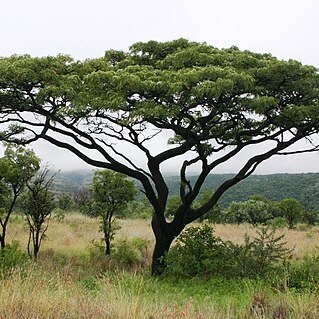Tree 4–20 m. high.. Bark grey to blackish, fissured and scaly.. Branchlets often rather thick.. Leaves silvery when young; petiole with rhachis 7–32 cm. long; pinnae (1–)2–5(–7) pairs, (3.5–)6–20(–28) cm. long; leaflets 6–15, elliptic or sometimes ovate-elliptic or ± obovate, mostly 1.5–7.5 cm. long, 0.7–4.2 cm. wide, obtuse or rounded and somewhat emarginate at apex, ± asymmetric at base, appressed-puberulous on both sides (or rarely pubescent–see note below); petiolule 2–5 mm. long.. Flowers white or pale green, in pendulous spikes 6–27 cm. long.. Sepals rounded at apex, erose and ciliate on margins.. Petals obovate-oblong, ± 4–5 mm. long and 2–2.5 mm. wide, rounded at apex, ultimately recurving.. Pods elliptic or narrowly elliptic, 4–6.5 cm. long, 2–3 cm. wide, brown.. Seeds elliptic, compressed, ± 9–12 mm. long and 7–8 mm. wide, brown; areoles ± 7–8 mm. long and 3.5–4 mm. wide.. Fig. 2, p. 22.
It can be a small or medium sized tree. It is often 5-8 m tall but also up to 21 m tall. It has a flat crown. The bark is dark and rough and flakes off. The twigs are robust ending in a stubby tip. The young growing tips are covered with velvety red hairs. The leaves are blue-green. The leaves are up to 38 cm long and droop. They are clustered near the ends of branches. The leaves are twice divided with 2-4 pairs of side branches and these have 5-11 leaflets. The leaflets are oval and 2.5 cm long by 1.9 cm wide. They are silvery when young. The flower buds are small and greenish-yellow. They occur in long strings at the ends of branches. The flowers are yellow with a sweet scent. The pods are 3-8 cm long and 1.9-2.5 cm wide. They are flat, brown and woody. They normally only have one seed.
Leaves: petiole and rachis together (3)7–24(32 in East Africa) cm long, appressed-pubescent to reddish tomentose when young, often becoming glabrous at maturity; pinnae (1)2–4(7 in East Africa) pairs; pinna rachis (3)7–16(23 in East Africa) cm long; leaflets 6–12(15 in East Africa) per pinna, (1.5)2.5–5.5(7.5) × (0.7)1.2–3.6(4.2) cm, usually immature at anthesis, ± obliquely ovate to rhombic, strongly asymmetrical at the base, obtuse to emarginate at the apex, usually silvery-sericeous when very young, becoming thinly pubescent to glabrous at maturity; leaflet petiolules 2–4(5) mm long.
Racemes 5–30 cm long including the peduncle, sometimes branched, pendulous and usually ± clustered at the ends of young branches, usually appearing with the young leaves; peduncle and axis pubescent to tomentose with appressed or spreading, brown or reddish hairs.
Tree, up to 15 m high. Branchlets rusty tomentose, with leaves clustered towards ends. Leaflets 5-15 per pinna, elliptic, basally asymmetric. Inflorescence spicate, spike 80-250 mm long. Flowers white, cream or pale green.
Pods (3.5)4.5–5.5(6.5) × 2–3 cm excluding the stipe, ± elliptic, slightly asymmetrical, brown; stipe 0.5–1.5(1.8) cm long; seeds 9–12 × 7–8 × 2 mm, elliptic to suborbicular, flat, brown, with areoles 7–8 × 3.5–4 mm.
Calyx 1.5–2(2.5) mm long, fused for third to two-thirds of its length, ± pubescent at least in its lower part, the teeth broadly rounded and ciliate.
Petals 4–5 mm long, but strongly reflexed about their middle after anthesis, 2–2.5 mm broad, rounded to somewhat pointed at the apex.
Flowers 4–5.5(6.5) mm from base to anthers, sessile, white or cream or occasionally greenish, pink or brownish.
Twigs rather stout, with conspicuous raised leaf scars, when young covered with a fine dark red tomentum.
Pendulous spikes of small creamy fragrant flowers crowded with the leaves at the ends of the branchlets.
A deciduous tree attaining 60–70 ft. in height, with stout knotted branchlets,
Tree 4–20 m high, the crown often flat, sometimes rounded.
Bark grey to blackish, fissured and scaly.
Blackish corrugated bark
Light silky foliage


